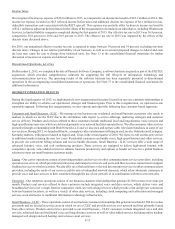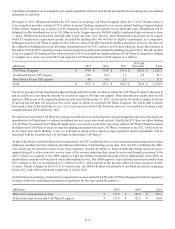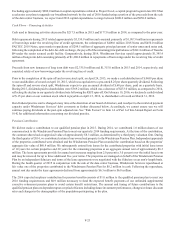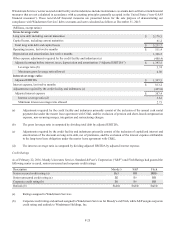Windstream 2015 Annual Report Download - page 150
Download and view the complete annual report
Please find page 150 of the 2015 Windstream annual report below. You can navigate through the pages in the report by either clicking on the pages listed below, or by using the keyword search tool below to find specific information within the annual report.
F-20
Broadband Stimulus
As part of the American Recovery and Reinvestment Act of 2009 (“ARRA”) approximately $7.2 billion was allocated for the
purpose of expanding broadband services to unserved and underserved areas. The Rural Utilities Service (“RUS”), part of the
United States Department of Agriculture, approved eighteen of our applications for these funds for projects totaling $241.7 million.
Under this program, the RUS funded 75 percent of these approved grants, or $181.3 million, and we funded the remainder of at
least $60.4 million. Over the duration of this program, which was completed during the third quarter of 2015, the RUS funded
$176.4 million of capital expenditures and we funded $142.3 million of capital expenditures. We have received all outstanding
funds from the RUS related to our approved applications.
IntraMTA Switched Access Litigation
Several of our companies are defendants in approximately 25 lawsuits filed by Verizon and Sprint long distance companies alleging
that our companies may not bill them switched access charges for calls between wireline and wireless devices that originate and
terminate within the same Major Trading Area. The complaints seek historical relief in the form of refunds and prospective relief
concerning future billings. There are approximately 50 other such lawsuits against hundreds of defendants. All of the suits have
been consolidated in a single federal district court, which dismissed the claims on November 17, 2015. The plaintiffs are currently
seeking permission from the district court to appeal the dismissal of their claims, which is required in this instance given certain
procedural issues. The subject matter of the suits is also the topic of a pending petition for declaratory ruling before the FCC, to
which the lawsuits may be referred. The outcome of the disputes is currently not predictable, given the uncertainty concerning the
ultimate venue of the disputes and the amount of traffic being disputed.
Last-Mile Access
Windstream is actively engaged in policy advocacy in various FCC proceedings that address the rates, terms and conditions for
access to the “last mile” facilities we need to serve retail customers through our competitive companies. In 2015, we incurred
approximately $1.4 billion in interconnection expense and most of that was attributable to last-mile access. For the vast majority
of our customers, last mile facilities, the wires (“loops”) to a customer location from a central office, are not economic for
Windstream to duplicate through its own investment and are not available from providers other than the incumbent carrier. Therefore,
we often lease those connections from incumbent carriers as one of two distinct product types: either unbundled network elements
(“UNEs”), which by law are not available in all areas but are subject to strict regulatory standards, or special access, widely
available from incumbents but subject to more flexible regulatory standards. One such FCC proceeding involves a comprehensive
review of special access rules, begun in 2012 with an FCC order finding that the special access rules the FCC has had in place
since 1999 were not working as intended. In addition, in October 2015, the FCC’s Wireline Competition Bureau commenced an
investigation into whether the volume and term commitments and associated fees and penalties contained in specified incumbent
special access pricing plans are anti-competitive, comport with applicable law or impede the forthcoming technology transition.
These proceedings are on-going, and we are not able to predict when the FCC will issue its decisions or the terms of FCC’s
determinations in these proceedings.
State Regulation and Legislation
State Universal Service
We recognize revenue from the receipt of state universal service funding in a limited number of states in which we operate. In
2015 and 2014, we recognized $107.8 million and $114.2 million, respectively, in state USF revenue, which included approximately
$59.5 million and $67.5 million from the Texas USF. These payments are intended to provide support, apart from the federal USF
receipts, for the high cost of operating in certain rural markets.
There are two high-cost programs of the Texas USF, one for large companies and another for small companies. In 2015, we received
$52.0 million from the large company program and $7.5 million from the small company program. The purpose of the Texas USF
is to assist telecommunications carriers with providing basic local telecommunications services at reasonable rates to customers
in high cost rural areas and to qualifying low-income and disabled customers. By order of the Texas PUC, the Texas USF distributes
support to eligible carriers serving areas identified as high cost, on a per-line basis. Texas USF support payments are based on the
number of actual lines in service and therefore are subject to reductions when customers discontinue service or migrate to a
competitive carrier. All service providers of telecommunications services in Texas contribute to the Texas USF through the payment
of a monthly surcharge collected from their customers.
























